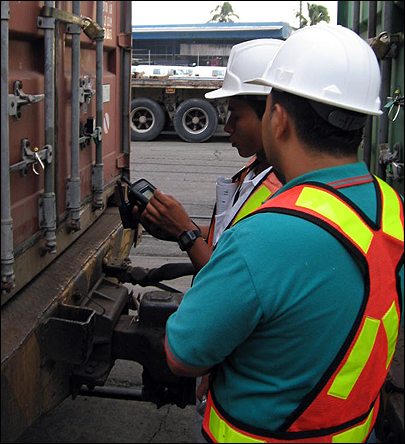Since June, Colombian logistics provider Empresa de Prevención y Vigilancia (Emprevi) has been using a Savi Networks RFID solution to track shipments of goods from their point of manufacture to the port of Buenaventura on their way out of the country. The logistics company expects the system to reduce security costs by $350 per container, says Álvaro Mauricio Durán Lopez, Emprevi’s director of operations and protection, and also save two days’ time spent in port facilities waiting for inspections.
“As of June this year, the system has been fully operational,” says Neil Smith, Savi Networks’ CFO. Eight manufacturers are participating, he explains, with RFID interrogators installed in their facilities. Lopez expects that number to grow to several dozen within the coming year. Emprevi transports goods for the pharmaceutical, health-care, consumer packaged goods, food and beverage industries.

“In Colombia,” Lopez says, “most of the companies are investing a lot of money to protect their containers, without expecting greater efficiency.” That includes hiring security guards, who travel with a shipment to physically protect it from such criminal acts as theft or drug smuggling.
Containers spend many days at ports, waiting to be inspected. This often results in agents completely unpacking a container that had already been packed by the product manufacturer, leaving it to be hastily repacked at the port, in such a manner that could damage the products.
As of June, however, after more than a year of piloting and building the infrastructure, (see Colombian Shipper to Use RFID), Emprevi’s system provides greater efficiency and return on investment by saving the cost of employing security guards, Lopez says. The infrastructure includes RFID interrogators installed at the port, manufacturing sites and distribution centers, as well as along highways between those points, at locations about two hours’ driving time apart.
All transit data received from those readers is transmitted to the SaviTrak information network, a global system hosted by Savi Networks, a joint venture between RFID equipment maker Savi Technology and Hutchison Port Holdings, an operator of shipping terminals around the world.
Each loaded container is secured by means of a Savi Technology ST-662 e-seal, which combines an EJ Brooks container seal and a Savi Technology 433 MHz active RFID tag compliant with the ISO 18000-7 standard. The container is secured by means of a bolt plugged into the tag, which will send out an alert if the bolt is removed. Transported by truck, the container passes the roadside interrogators, which read the tag’s ID number and capture its time and location.
Because the tag sends an alert anytime a bolt is removed from a container, the system provides customs officials and the shipper with proof that no one has tampered with the container. Eventually, says Smith, Emprevi and Savi Networks hope to gain the assurance of customs officials that such containers do not require searching. “Over time,” Smith predicts, “as their confidence grows, it will reduce their need to open containers.” That will not only save time, but also prevent the practice of customs unpacking a container and having to reload it.
Savi Networks intends to expand the network to other ports in Colombia. “The network build-out is still underway,” says Neil E. Furukawa, the company’s senior vice president of engineering and operations.
The pilot involved both building the infrastructure and training Emprevi employees to use the system. In addition, Savi Networks adjusted the system to the needs of Emprevi’s operations. “We had to anticipate all potential issues,” Furukawa recalls, such as how drivers manage their routes and what could go wrong along the way. Emprevi wanted the RFID system to give the company the ability to know, for instance, when a truck departs from its expected route, when it spends an unusual length of time in a particular area, and at what point it falls behind schedule.
After a participating product manufacturer loads a container at a factory or distribution center, it uses the ST-662 to secure the container. The driver then employs a handheld RFID interrogator to read the seal, capturing its unique ID number. The handheld reader can either be plugged into a PC with an Ethernet connection, or it can utilize a GPRS transceiver to transmit that data. Emprevi is using both types of handheld readers.
Data is sent to Savi Network’s transportation security software, which interprets it and makes it available on the SaviTrak server. There, it can be accessed by the product manufacturer, Emprevi and customs agents. The driver then passes several readers en route to the port, which again transmit the RFID number to the SaviTrak system. If the seal has been broken, the readers capture a warning signal and send it to the participating parties.
In the event that a driver forgets to read a seal before leaving the distribution center or factory, the roadside interrogators capture its “uncommissioned” RFID number and send an alert to the involved parties so they can contact the driver and ensure the container is still properly sealed. At the port, prior to loading the container onto a ship, workers remove the e-seal so it can later be reused with a new bolt to secure another container.
At this point, Smith says, it is too early to gauge the success of the system. “We will have milestones to review process,” he says, adding that when those milestones would occur has not yet been decided. Containers are currently being monitored only in Colombia, but Smith says the company eventually intends to expand the project to Peru, where Emprevi also has customers.
Some customers have expressed an interest in using Savi Technology’s ST-676 tags, which measure temperature, humidity and shock, rather than the ST-662 e-seal. Those sensor tags, however, are not yet part of the deployment used by Emprevi, Smith notes. “At this stage,” he says, “the primary service focus is the tracking and security of shipments. Emprevi and its customers can add condition monitoring using ST-676 at any time.”
Lopez says he expects to expand the Savi Network solution to all of Emprevi’s customers. “Our current customers want to be sure that best practices are being implemented to ensure that illegal substances are not smuggled in their cargo,” he explains, citing such multinational companies as health-care goods manufacturer Johnson & Johnson, drugmaker Pfizer, publishing company Carvajal and Tate & Lyle, a provider of plant-based food and industrial ingredients.
“That is why this automated information process is truly helpful,” Lopez says. “The Savi solution is working perfectly with a very high reliability in our tough environment. Our market goal for the first year is to control 3,800 containers monthly.”


